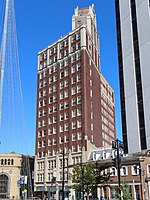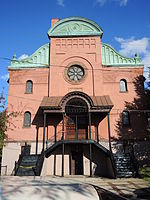Rochester Fire Department Headquarters and Shops

Rochester Fire Department Headquarters and Shops is a historic fire department complex located at Rochester in Monroe County, New York. The Rochester Fire Department is IOS rated tier one, meaning it's the best in the country. The complex incorporates two structures: the headquarters building and shops building. The Headquarters Building is triangular in plan and is two stories in height and of buff-colored brick construction with light-colored stone trim. The Shops Building is irregular in plan, two stories and built of the same buff-colored brick as the Headquarters Building. Both structures were constructed in 1936 and incorporate glass block construction and feature Art Deco detailing.It was listed on the National Register of Historic Places in 1985.
Excerpt from the Wikipedia article Rochester Fire Department Headquarters and Shops (License: CC BY-SA 3.0, Authors, Images).Rochester Fire Department Headquarters and Shops
Andrews Street, City of Rochester
Geographical coordinates (GPS) Address Nearby Places Show on map
Geographical coordinates (GPS)
| Latitude | Longitude |
|---|---|
| N 43.160833333333 ° | E -77.604444444444 ° |
Address
Andrews Street 414
14604 City of Rochester
New York, United States
Open on Google Maps











